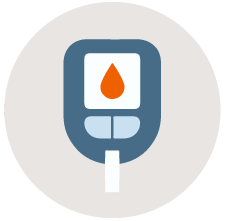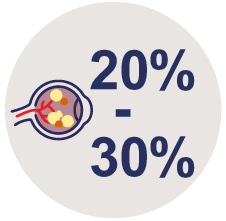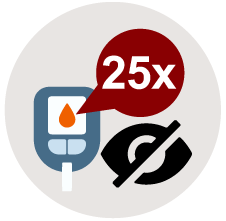


Diabetic retinopathy (diabetic eye)
Diabetic retinopathy(commonly known as diabetic eye) is one of the complications of diabetes. Improper blood sugar management damages the endothelium of retinal blood vessels, causing microfilament vasculopathy. The retina is covered with tiny blood vessels, and lesions can cause vascular obstruction and reduce the blood supply to the retina, resulting in hypoxia and triggering the growth of new blood vessels. Abnormally fragile new blood vessels can easily rupture, bleed, and leak into the vitreous body. Hypoxia in the retina can lead to edema and death of optic nerve cells, resulting in vision loss. Diabetic eye can cause a series of pathologies such asglaucoma symptoms, retinal detachment, which may cause severe vision loss.
Causes of Diabetic Eye

Complications of diabetes mellitus

Diabetes for 5 years or more: 20-30% chance of developing diabetic eye

Diabetes for 15 years or more: 80% chance of developing diabetic eye

The risk of blindness is 25 times higher in people with diabetes than those without if the retinopathy is not treated properly.
Symptoms of Diabetic Eye

Mild cases
No obvious symptoms, vision not significantly affected: control of blood glucose levels and regular eye examinations are required

Moderate cases
Some patients remain without symptoms and are placed under continuous observation, but preventive treatment will be provided if necessary.

Severe/Very severe cases
If the vision has been impaired and having blurry eyes, Eye Floaters, eye pain, blurred central vision, or similar symptoms, medication or laser therapy should be used to control the condition. In more severe cases, surgical treatment may be required.

Mild cases
No obvious symptoms, vision not significantly affected: control of blood glucose levels and regular eye examinations are required

Moderate cases
Some patients remain without symptoms and are placed under continuous observation, but preventive treatment will be provided if necessary.

Severe/Very severe cases
If the vision has been impaired and having blurry eyes, Eye Floaters, eye pain, blurred central vision, or similar symptoms, medication or laser therapy should be used to control the condition. In more severe cases, surgical treatment may be required.
Treatment Methods

People with diabetes are at higher risk of developing diabetic eye disease compared with the general population. It is recommended to have a diabetic eye examination once a year, and to keep blood sugar, blood pressure, and cholesterol levels under control. If diabetic eye disease does develop, the following treatment approaches may help improve the condition:
Laser Regulation Method
Apply laser to destroy oxygen-deficient retina to prevent the growth of diseased blood vessels and to reduce leakage. The treatment also stimulates the peripheral retinal cells to absorb water, reducing the condition of macular oedema.
眼內注射
Intravitreal Anti-VEGF Injection
Inject anti-VEGF drugs into the vitreous to help inhibit vascular proliferation and vascular endothelial growth in the eye. It is expected to improve vision by reducing vascular leakage and bleeding.
Vitrectomy
In severe cases such as retinal detachment, intraocular haemorrhage or persistent macular oedema, vitrectomy can help restore vision. However, this is a complex procedure with a success rate ranging from 50% to 80%, depending on the individual case.
Eye Examination Schedule

Diabetics under 30 years old
It is recommended that eye exams be performed within 5 years of the discovery of diabetes and annually thereafter

Diabetics over 30 years old
It is recommended to have an eye exam as soon as you find out you have diabetes, and annually thereafter.

The pregnant
Pregnancy can cause a rapid worsening of diabetic eye disease. When you are pregnant with diabetes, you should have an eye exam as soon as possible.

